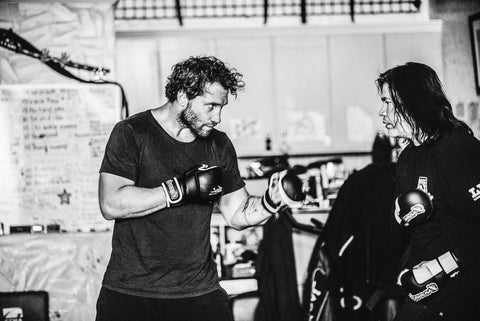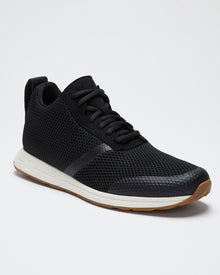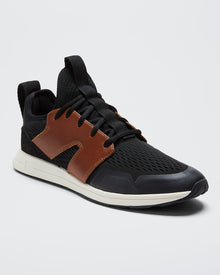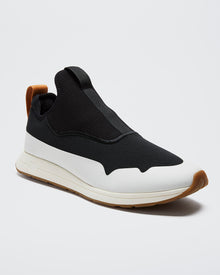10.22.16Bold Apps
AN INTERVIEW WITH ALEXANDER RICHARD MESQUITA BY LINDSEY BYRNES

ALEXANDER RICHARD MESQUITA
Alexander Richard Mesquita, who goes by Richard or sensei to those who train with him, has been teaching American Kempo for 21 years. Right before he got his black belt in 1999, he started learning Gracie jiu-jitsu by training with the Gracie family. The Gracie family is a prominent martial arts family from Brazil known for their development of Brazilian jiu-jitsu. From there, Richard has trained with Wander “the Crusher” Braga, Alexandre Novaes, Eddie Bravo, founder of 10th Planet Jiu-Jitsu, and most recently Eddie Bravo and Steve Baca from NOHO MMA.
Richard opened his dojo (a Japanese term which literally means “a place of way”), “Richard Mesquita Martial Arts” in Echo Park seven years ago. The dojo offers boxing, kickboxing, self-defense techniques, jiu jitsu, and yoga. He loves teaching. And learning. He teaches his students everything he learns.

Richard trains a lot of actors for movies as well. His client list is a who’s who of Hollywood: Cara Delevingne, Will Smith, Jared Leto, Margot Robbie, Jai Courtney (shown above) and Jay Hernandez all for Suicide Watch, Forest Whittaker for End of Watch, Keanu Reeves for Street Kings – the list goes on. He loves to teach and working in the movie industry enables him to offer super affordable classes at his dojo, where there are a lot of lower income families. It’s part of his MO to make training super accessible for everyone.
LINDSEY BYRNES
Lindsey Byrnes is an established LA-based photographer who has shot for magazines like Rolling Stone, Spin, Paper, Esquire and Billboard. Her portfolio is a who’s who of musicians and celebrities, having photographed Pvris, Lolawolf, Kristen Stewart, The Naked and Famous, Brian Anderson, Snoop Dogg and Charlie Heaton (Stranger Things) to name a few. Through the lens of her camera, she captures the moments at live shows that make you feel alive. She met Richard a few years ago, trained with him to get her yellow belt and became fast friends.
LINDSEY AND RICHARD MEET
To listen to the story, you might say Lindsey and Richard’s chance meeting was less chance and more synchronistic. She was feeling down. She took a walk on a hot summer night and decided to pop her head into the dojo after walking past it for 2 years. Richard happened to come out and say hello, and Lindsey describes it as if he could sense she was looking for something. He said he would teach her if she was interested. She thought: maybe this is exactly what I need.
Richard says he definitely has a connection with those he teaches. Sometimes he’s drawn to people, and sometimes they’re drawn to him. Seems like in this case, it was a mutual draw. Because they have such a special bond, Lindsey volunteered to interview Richard for this piece. And since they have that bond and mutual respect, we will refer to him as sensei for the remainder of the interview.

Sensei (先生) is a Japanese term that means teacher. The word is also used to show respect to someone who has achieved a certain level of mastery in an art form or some other skill.
LB: Why don’t you tell us how you got started in this line of work?
SENSEI: I started in the backyard with my dad when I was 4 or 5 years old. He would bring all the neighborhood kids [in South Central LA] into the backyard and we would box. My dad was a heavy weight champion in the Marine Corp – he was the first Native American to get that title. He taught us basics like jabs, one-two combos, uppercuts, etc. I did that for a number of years, and then I played football, baseball, and basketball, and then I wanted to do something besides organized sports. So I checked out different martial arts and decided on Kempo in Pasadena.
When I was a yellow belt, my teacher asked me to teach one of the other students a basic technique. After the lesson, my teacher said if I taught, they wouldn’t charge me tuition. So he gave me a few students, and when I was a brown belt, he asked me to be a full fledge teacher working a full schedule.
LB: How did you get into working on movies?
SENSEI: A friend of mine was writing and directing the movie “Harsh Times” and asked me to train Christian Bale. I remembered Christian from American Psycho—he’s a fucking madman in that movie--I love that movie. So I met Christian and Freddy Rodriguez and we started training. Ever since then, I’ve been doing a movie every year and half for the last 10 years and I love it. What it is to me is an expression or a concrete moment in Kempo history. For me, Kempo involves jiu jitsu and boxing – it’s all-inclusive.
LB: What inspired you to open the dojo?
SENSEI: I always wanted to. I think I was destined to be a teacher. Having your own school inspires you to do stuff.
LB: The classes at the dojo are super affordable. I imagine that working on movies helps with that. Is that part of your business plan, to be able to help neighborhood kids?
SENSEI: Yes, I want to make it affordable because I know a lot of these kids can’t afford Pasadena prices where I come from. A lot of the students here are low income. Over half of them don’t have cars. A lot of them collect recycling to pay their tuition. So I don’t want to jack it up. I want to make it so everyone can train. For one price, you get boxing, kickboxing, self defense techniques, jiu jitsu, and yoga—everything is the same price.
LB: Tell me the difference between teaching a 5 year old and a 45 year old.
SENSEI: Adults have more excuses. And those excuses are more elaborate. I can’t do this, I can’t do that. I always call them on it. I’m 48 years old and I’m doing it. Adults have a million excuses. Kids don’t. For the most part, kids always go 110%.
LB: You don’t sleep. You’re training all these people. How do you take care of yourself mentally and physically?
SENSEI: I eat well. I eat a lot of good food. And I smoke a lot of weed. It helps with injuries and my mental state. But one thing I’ve been doing the last 15 years, I’ve been putting a lot of positive thoughts into my head continuously. I take little pauses as much as I can. I’m always trying to give myself positive affirmations.
LB: You’re also really into music. How does that play into your lifestyle?
SENSEI: For me, music is therapeutic. It helps me with all kinds of stuff emotionally -- it levels me out. I still have my guitars. In the old days, I used to play up and down the strip. But because of all the excess, I had to do something else. I was getting worn out. That’s when I got into karate and devoted myself to martial arts.
LB: I feel like the biggest lesson that I learned here, which I think about all the time, is when to tap out. That seems to be a theme: not having too much ego and being outside of yourself.
SENSEI: In martial arts, there’s always a humbling situation that makes you realize you’re really fucking human. When I first did jiu jitsu, I remember I had never broken anything in my life. The first two months I was there, this guy had me in a position I couldn’t get out of it. My teacher walked by and said “Alex, why don’t you tap it?” I said I was all right. Right when I said that, my elbow popped out. My right knee popped out 5 times over there. My left knee twice. My left arm twice. I tore my trapezius muscle on both sides. Wow, man. You realize you are such a fragile creature.

LB: What would you say the best piece of advice you’ve ever been given in terms of fighting?
SENSEI: Think before you do. There are a lot of times where I almost got into a fight thinking the situation was what it was. Then I realized I had it wrong. I took a step back and gave it some space. I realized, oh shit, I almost got into a fight under the wrong pretenses. Think it out. A lot of times people get into fights and realize, oh shit, I fucked up. It was an innocent situation that I just misinterpreted. Take your time and stop and access and then act. Don’t act on emotion. Take your time and be cool. And when in doubt, just walk away.
LB: What does being a fighter mean to you?
SENSEI: A fighter fights when he has to fight. Like a fire fighter. They’re not walking around with a hose. There are things that happen to prepare, to stay calm, and then they apply the techniques necessary to put the fire out. It’s the same thing with a fighter. You’re trained to use these tools only in situations where there is a real threat. You have to recognize a real threat. Not just someone talking shit. It’s all in the eyes. It truly is. And after you look at the eyes you can see how they move. I can look at people and just size them up.
My life has always been very erratic and busy, but when I discovered martial arts I realized this is one thing that is going to fix a lot of shit. And after that shit was fixed, I realized I don’t need much else. The big thing I’m trying to do is give away all my material stuff. I want to live very, very simply.
To learn more about Lindsey & Richard:
https://www.facebook.com/RMMAechopark/
All photos credited to Lindsey Byrnes.




